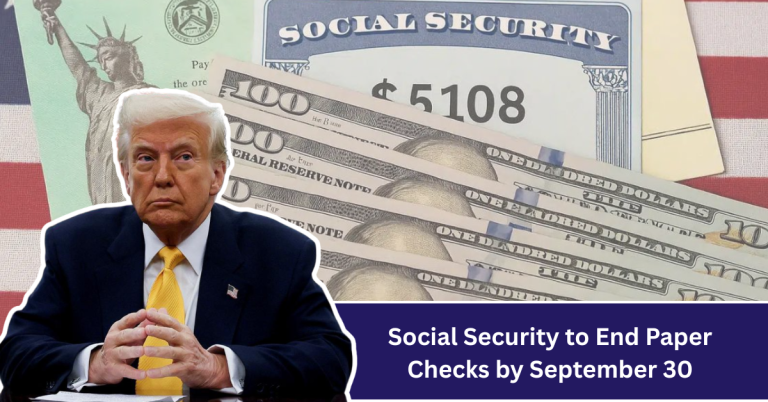If you or someone you know receives Social Security benefits through paper checks, it’s time to take notice. The Social Security Administration has announced that paper checks will be discontinued starting September 30. This significant change will affect millions of beneficiaries across the country who have been receiving their payments via traditional mail.
While this transition may seem sudden, the move to electronic payments has been in the works for years. The Social Security Administration encourages all current paper check recipients to make alternative arrangements before the deadline. This guide will walk you through everything you need to know about this important change and how to ensure you continue receiving your benefits without interruption.
Understanding Social Security
Social Security is a federal program that provides financial assistance to retired individuals, disabled people, and surviving family members. Established in 1935, this program serves as a critical safety net for millions of Americans who have paid into the system through payroll taxes throughout their working lives.
According to the official Social Security Administration, more than 65 million Americans receive Social Security benefits each month, with retirement benefits being the most common form of assistance. The program aims to ensure that seniors and vulnerable individuals have a steady income source even when they can no longer work.
The September 30 Deadline Explained
The Social Security Administration has set September 30 as the final date for mailing paper checks to beneficiaries. After this cutoff date, no new paper checks will be issued, and all existing accounts must be set up to receive benefits electronically. This deadline applies to all federal benefit payments, including Social Security, Supplemental Security Income (SSI), and veterans’ benefits.
This transition to electronic payments is part of a broader effort to reduce costs, increase efficiency, and enhance security. The shift aligns with the Treasury Department’s goal of making all federal benefit payments electronic by 2019, though this implementation has been extended to accommodate various circumstances.
Who Will Be Affected by This Change?
Anyone currently receiving Social Security, SSI, or other federal benefits via paper mail will be affected by this change. This includes both new beneficiaries and those who have been receiving paper checks for decades. The change impacts approximately 20 million Americans who still receive their benefits through traditional paper checks.
In particular, older adults living in rural areas, those without bank accounts, and individuals who prefer the simplicity of paper payments may face challenges during this transition. The Social Security Administration has identified these groups as requiring additional support and resources to adapt to electronic payment methods.
How the Transition Process Will Work
The transition will occur in phases, with increasing emphasis on electronic payments. Beneficiaries will receive multiple notifications about the transition timeline, including letters, phone calls, and in-person assistance if needed. Those who have not switched to electronic payments by September 30 will automatically be enrolled in the Direct Express® debit card program.
The Direct Express® card function like a regular debit card, allowing beneficiaries to access their funds without needing a traditional bank account. According to the U.S. Department of the Treasury, this service has served as an alternative to paper checks since 2008, providing secure electronic access to benefit payments for millions of Americans.
Alternative Payment Options Available
Beneficiaries have several electronic payment options to choose from. The most common is direct deposit, where payments are automatically transferred into a checking or savings account at a financial institution each month. This option is free, secure, and eliminates the risk of lost or stolen checks.
For those without traditional bank accounts, the Direct Express® debit card program offers a convenient alternative. This prepaid card allows beneficiaries to make purchases, withdraw cash at ATMs, and receive their payments on the same day they are issued. Additionally, third-party mobile payment apps may also be an option for younger beneficiaries who prefer digital payment solutions.
Benefits of Electronic Payments
Electronic payments offer numerous advantages over traditional paper checks. First, they eliminate the risk of checks being lost in the mail or stolen. Second, funds are available immediately on payment dates, rather than requiring a waiting period for checks to clear. Third, electronic payments are more environmentally friendly, reducing paper usage and waste.
From a societal perspective, electronic payments save the government approximately $1 billion each year in postage and administrative costs. These savings can be reinvested to benefit all Social Security recipients by helping to ensure the long-term solvency of the program. Additionally, electronic payments reduce the administrative burden on local post offices, particularly in rural areas.
Preparing for the Transition
If you’re currently receiving paper benefits, it’s important to take action before the September 30 deadline. Start by contacting your financial institution to set up direct deposit. Many banks offer assistance specifically for Social Security beneficiaries, including special accounts that may have lower fees or other benefits.
For those who prefer the Direct Express® card, enrollment can be completed online, by phone, or by visiting a local Social Security office. The card is typically delivered within 7-10 business days after enrollment, so it’s important to apply well in advance of the deadline. Social Security offices also provide assistance for those who may need help navigating the transition process.
Frequently Asked Questions
What happens if I don’t choose an option before September 30? If you haven’t selected an electronic payment method by the deadline, you will automatically be enrolled in the Direct Express® debit card program without needing to complete an application. Your first payment through this program will be issued according to your regular payment schedule.
Is there a fee to switch to electronic payments? No, switching to electronic payments is free. Direct deposit is available at no cost, and the Direct Express® card charges only for certain optional services, such as ATM transactions at out-of-network locations or paper statements. The basic card usage and withdrawals at in-network ATMs are always free.
Can I switch back to paper checks if needed? Once electronic payments are in effect, it will not be possible to switch back to paper checks. This permanent transition is part of the government’s effort to streamline payment systems and reduce costs. However, if there are exceptional circumstances that prevent you from using electronic payments, you should contact your local Social Security office to discuss your options.
How do I know if my direct deposit information is correct? Before the deadline, you can verify your direct deposit information through your my Social Security account online or by visiting your local Social Security office. It’s important to confirm that your account and routing numbers are accurate to ensure that your benefits are deposited into the correct account each month.
Resources for Additional Help
The Social Security Administration offers multiple resources to assist beneficiaries during this transition. The official Social Security website provides comprehensive information about electronic payment options and the enrollment process. Additionally, the agency has established a dedicated helpline for payment-related questions and concerns. For in-person assistance, all Social Security Security offices can help with enrollment and answer questions about the transition.
Many community organizations also offer assistance, particularly for older adults and those with limited internet access. Local senior centers, libraries, and area agencies on aging often have staff members who can help with the transition process. These resources are especially valuable for individuals who may need additional support navigating financial technology changes.






